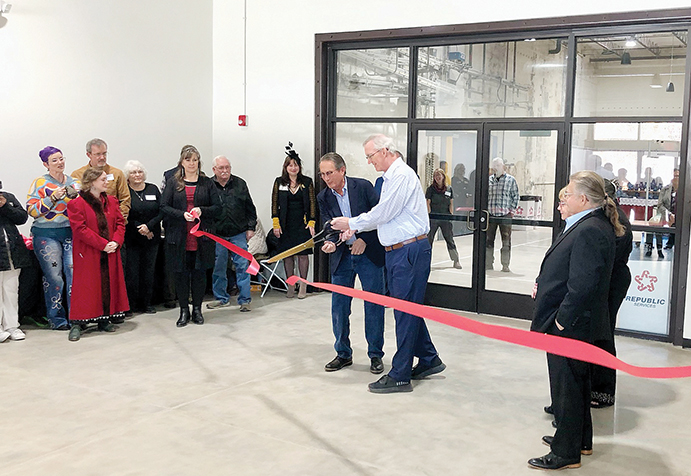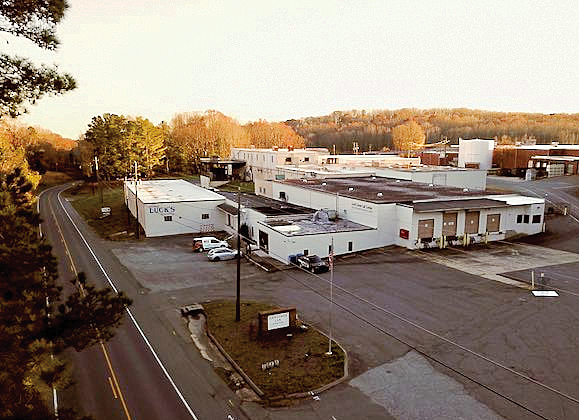Welcome!

Seagrove Mayor David Fernandez and Sopona Manufacturing President Dean Lail cut the ribbon marking the opening of the latest addition to the Luck Comer Lail complex. Photo by Carey Durham for the Randolph Hub
Mission accomplished
ASHEBORO — Turning the historic Luck’s Cannery into an event center sounded like a wild idea to some.
But, with the collaboration of many people and government grants, a ribbon cutting for Phase 2 of the Luck Comer Lail Center was held Nov. 22 to kick off the 17th annual Celebration of Seagrove Potters.
 H.R. Gallimore, chair of the Asheboro/Randolph Chamber of Commerce Board of Directors, welcomed those gathered for the opening of Phase 2. “It’s been a long effort by a number of people,” he said of the public-private project.
H.R. Gallimore, chair of the Asheboro/Randolph Chamber of Commerce Board of Directors, welcomed those gathered for the opening of Phase 2. “It’s been a long effort by a number of people,” he said of the public-private project.
Noting that the Luck Comer Lail Center will be the largest event center in Randolph County, prior to the opening of the new Farm, Food and Family Education Center at least, Gallimore said businesses that occupy the rental area of the historic old cannery have created 40 jobs, with room for more enterprises.
Plans are to add four pickleball courts.
Seagrove Mayor David Fernandez followed Gallimore, saying, “We’ve worked hard to get here.” He thanked NC Sen. Dave Craven for helping get funding from the state as well as “a lot of donors here.”
Fernandez recalled looking for a space to continue the annual pottery festival when Dean Lail offered the cannery to the town. The property donated to Seagrove is five acres with 90,000 square feet of interior space.
With that said, Lail and Fernandez together cut the ribbon, allowing visitors to move into the room where potters had set up booths for the Celebration of Seagrove Potters.
Lail’s father, Jack Lail, had purchased the property in 2017 and used the upper portion for Sapona Plastics to manufacture products, creating 25 jobs.
Jack Lail said on the website https://luckscannery.weebly.com/, “Our objective is to expand production and warehousing in the upper building with a vision to provide the lower building to the local community for the pottery celebration, economic development and other uses.
“The town of Seagrove found our vision very appealing and offered to accept the building donation with the stipulation that we clean it up, sell off the equipment and line up funding for repairs and maintenance. We are glad to be able to do something positive for the community and economy while revitalizing the vacant building that had been severely vandalized.”
The event portion of the property totals 28,000 square feet with eight rooms, offering meeting places for small groups to large crowds, from the conference room that seats 12 to the Wavie Presnell Convention Center that can accommodate nearly 600.
On the industrial side, current occupants are Eastern Steel Works, Walker Art/Carolina Bronze and LA Cabinets. More space is available for businesses.
Dean Lail said that about $3 million has been invested in the project to date, with $2.1 million from government grants and the remainder from Randolph County and private donors.
John Stratten of Eastern Steel Works said his company fabricates bridge components and ships them to the Mid-Atlantic states. He employs 12 workers. “Seagrove is good to do business with,” he said. He noted that his company provided the metal handrails for the venue.
Fernandez said all the work so far is the result of government grants from the state and county. “We’ve done it without raising taxes so there’s no burden on locals,” he said. “In the pottery community, everybody has been very supportive.
“But there’s a lot to go and hurdles to get over.”
The Luck’s Cannery website provides a brief history of the site: “In 1947 Alfred Spencer, Ivey Luck and H. Clay Presnell started Mountain View Canning Company. The Cannery was located in Seagrove in a scenic rural area. Pinto beans were canned and the company eventually changed the name to Luck’s. The company grew in success and employed many people in the area. The aroma of over 600 cans per minute cooking no longer fills the air along Highway 705. It was sold to ConAgra in 2000 and closed in 2002.”
A couple of efforts were made afterwards to bring the cannery back into production. But those enterprises failed. Now it’s up to Seagrove and others to make a success of the vision for a multi-use facility celebrating the art, culture and history of Seagrove, as well as economic development.
